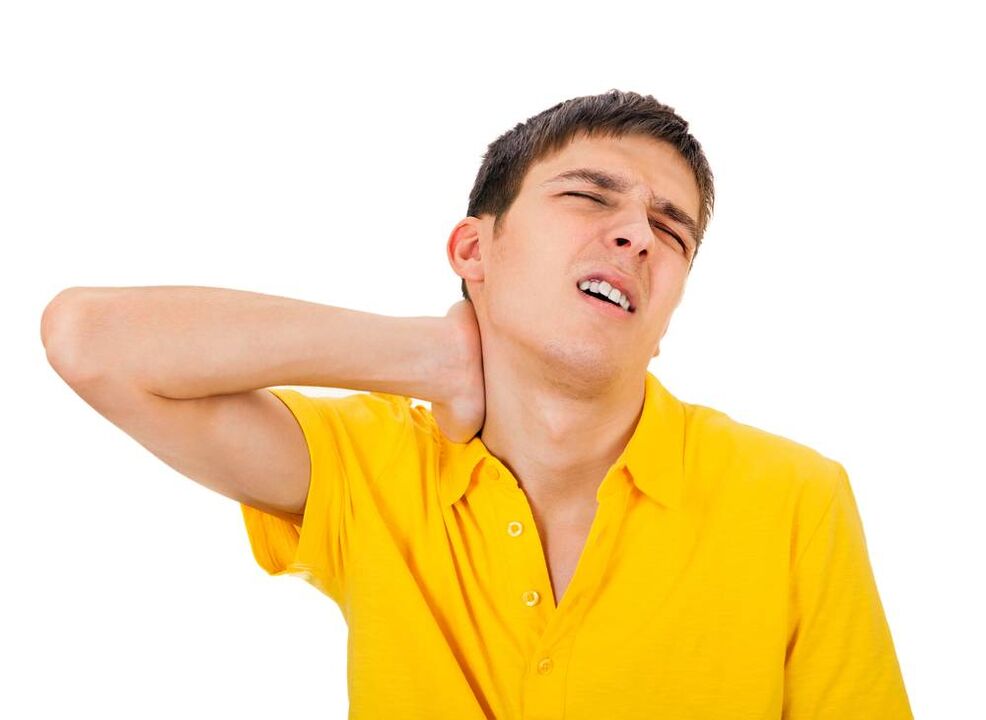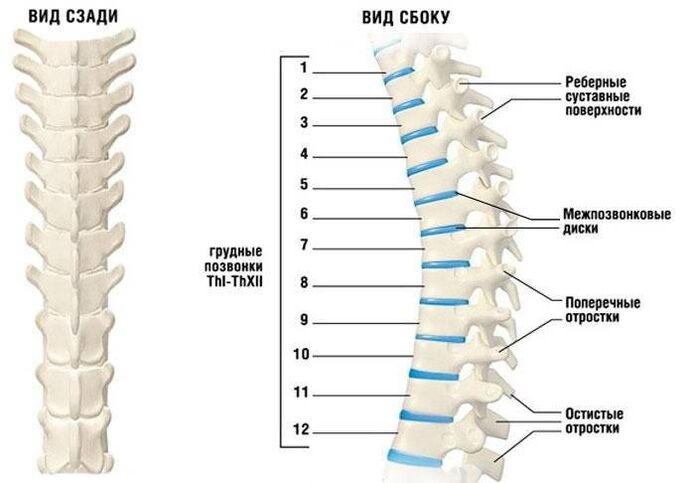Currently, medical statistics show that almost every person under 25-30 years of age complains of cervical osteochondrosis.The disease affects this spine more often than others.Pathology is a progressive degenerative process that affects the interactive discs of the vertebrae and the vertebrae in the neck.The disease is the same for men and women.This is a dangerous and complex form of osteochondrosis because of the large blood vessels around the neck that provide the brain and many nerve endings.Involvement and blood flow violations lead to deterioration of oxygen and nutrients in the brain.

Signs of illness
The symptoms of osteochondrosis of the cervical spine are more prominent than other parts of the spinal column, even with minor damage.This is due to the fact that the vertebrae are located near each other and the intervertebral discs are low height.Such anatomical feature contributes to the fact that osteochondrosis, nerve endings, spinal cord, blood vessels are often compressed.
General symptoms:
- pain syndrome;
- decrease in weakness and sensitivity in the upper limbs;
- limiting cervical mobility;
- violation of coordination of movements;
- frequent dizziness;
- general weakness;
- Deterioration of the functioning of the organs of perception (hearing, vision, touch, taste).
The pains are more often localized around the neck, adding them to the back of the head, shoulders, arms.The upper limbs hurt when the nerve spine is intended for the injured vertebrae, which is responsible for innervation.Pain in the back of the head is due to spastic contractions of the cervical muscles associated with occlital bones and blood circulation violations.
The weakness of the hands in patients is observed when the nerve spine is involved in the pathological process that ensures the innervation of the upper limbs.Restoring mobility and a typical crunch when rotation or overthrowing the neck occurs when the cervical vertebrae appears, the height of intervertebral discs decreases and is affected by the joints between the vertebrae.
The vertebrae in the neck have transverse processes that form a channel in which the brain is running artery.The osteochondrosis of the cervical spine is pushed out and the connective tissue increases.This leads to compression of the cervical artery, and the blood supply to the back of the cerebellum and the back of the brain.As a result, a person often has dizziness, coordination of movements, and general weakness disturbances.In advanced cases, if the artery is involved in the abnormal process or pushes it strongly, the cerebellum, the occlital part and the brain stem are significantly worsening.In this case, the functionality of the hearing and vision organs, the numbness of the tongue and the fingers decreases.
Signs of the disease depend on which of the eight vertebrae is affected by a dystrophic or inflammatory procedure.Disorders of sensitivity and movement lead to damage to cerebrospinal roots, which are affected by certain vertebrae.Depending on this, the following manifestations of the cervix are observed:

- The first vertebrae - the neck of the head and the occlital part of the head and their sensitivity decrease;
- The second - the pain of the crown and the sun can be felt;
- The third - the pain is felt, and the sensitivity reduces the part of the neck where a chopped spinal cord is located, the intensity of the flavor sensation is reduced and the speech damage is present;
- The fourth - the pain radiates in the shoulder, the scapula, the patient is disturbed by heartache, respiratory disorders, and the sound of the neck muscles decreases;
- Fifth - the pain in the neck is given to the outer surface of the shoulder;
- The sixth - cervical pain is radiated into the shoulder blade, feeling in the forearm and thumb;
- Seventh - they give pain to the shoulder blade, the back of the shoulder, the forearm and the fingers (from the second to the fourth);
- The eighth - the pain spread from the neck to the shoulder, the forearm and the little finger.
Depending on the prevalence of lesion, the difference between the four degrees of osteocondrosis of the cervix is different.This is not the stage of the disease, but the severity of the symptoms, as it is common in the pathological process and what kind of vertebrae affects.
- At first instance, clinical symptoms are absent or minimal.Patients complain of mild pain and increase during the movement of the head.Treatment began at this stage of the disease will be effective.However, people often ignore or do not feel disturbing symptoms, so they do not consult a doctor.
- The worsening of the pathological process enhances the symptoms.In the second stage, the pain becomes more pronounced, giving it to the upper limbs, the blades.At this stage of developing a degenerative process, the height of the intervertebral disc decreases, resulting in the nerve fiber.This will be the cause of increasing pain.The second degree of osteochondrosis of the cervix is characterized by the appearance of headache, the deterioration of the well, and the decrease in working capacity.
- The third degree of osteochondrosis of the cervix is distinguished by the development of the intervertebral disk affected.Neck mobility is limited and the patient feels severe pain by palpation.With this spread of the pathological process, the pain becomes constant, radiated to the upper limbs.The voltage of the muscles fixed to the occlital bones is felt.Patients complain of frequent dizziness, general weakness, and numbness of hands.
- The fourth degree of osteochondrosis of the cervix is diagnosed when the intervertebral disk is completely destroyed by a dystrophic procedure.This is replaced by fibrous tissue, which leads to a significant restriction of mobility.The spinal cord and the blood vessels in the neck are affected.Such changes are characterized by a significant deterioration in the blood supply of the cerebellum and the occlital of the brain.Oxygen starvation leads to a violation of coordination of movement, hearing loss, vision, tongue, speech disorders.
Treatment methods
In time, seeking a doctor when the first alarming symptoms appear, discomfort around the neck, the reaction from the nervous system prevents degenerative changes.Treatment of cervical osteochondrosis consists of complex therapeutic measures.Including:
- taking medications;
- massage;
- physiotherapy physical education;
- Physiotherapy procedures.
Medication
Doctors prescribe anti -inflammatory drugs to reduce the intensity of the pain, to reduce the nerve pair inflammatory and reduce swelling.Condroprotectors restore the damaged cartilage tissue on the intervertebral plate.Musorelaxants relax the neck muscles and relieve cramps.Medicines to improve blood flow promote the blood supply to the brain.Vitamins B activate metabolism in the nerve tissues.With intense pain, your doctor may prescribe painkillers.If the patient has a painful pain syndrome, the painkillers are placed parenterally after the pain disappears, they will switch to tablets.
Physiotherapy methods
Physiotherapy is an effective way to overcome the cervical region osteocondrosis.It is essential to treat this disease with such techniques, after which the following results are achieved:
- The intensity of the pain is reduced;
- The restoration of the affected bone, cartilage and muscle tissue is activated;
- The muscles and voltage are removed in the muscles;
- The inflammatory process is stopped;
- Oxygen and nutrient entry improve into the affected area and to the brain.
The following types of procedures are most effective in treating osteochondrosis:
- drug electrophoresis (the affected area acts with electric shock that improves the entry of the drug into the tissues affected by the degenerative procedure in addition to the restoration of blood flow and tissues);
- Ultrasonic therapy (patients' metabolic processes are activated, pain is reduced, inflammation stops);
- Magnetic therapy (relieves swelling from the affected area, which helps to reduce the intensity of the pain);
- Laser therapy (improves blood circulation in the abnormal process and has an anti -inflammatory effect).
Medical physical education
Exercises are prescribed at a time when the acute manifestations of the disease are stopped.Do not feel discomfort and pain during gymnastics.The complex should be performed after long -lasting remission to prevent relapse.

- Take a place lying on the stomach, lift your head and body, leaning on your hand.The back is straight, the breath is deep and even.Leave for two minutes and then slowly take the starting position.The number of repetitions is 3.
- The situation lies on the stomach, the hand along the body.Slowly turn your head and try to touch your ears on the floor.Repeat 6 times on both sides.
- Sitting or standing, tilt your head for an inhalation and try to reach your chin to the chest.When exhaling, take your head back smoothly and lift your eyes to the ceiling.The number of repetitions is 10-15.
- The good practice to strengthen the cervical muscles is to push the forehead on the hand.To achieve the effect, press your palms and forehead on your palms for 30 seconds.Repeat three times.
- Rotate your head in a circle.Slowly and smooth the exercise.In each direction - 10 revolutions.The occurrence of dizziness during movements is unacceptable.If this happens, you must stop immediately.
Massage
The course is prescribed by a doctor in the absence of acute pain, only a medical education specialist can do so.For such a disease, it is not advisable to contact non -professionals.
Therapeutic effect of the massage of the collar area:
- Blood flow and lymphatic improve in the affected area;
- The muscles rest, the cramp is removed;
- The intensity of the pain is reduced.
Surgical intervention
Surgery appears when conservative therapy does not produce results within six months, and the patient is observed by severe pain, nerve fibers and signs of myelopathy.If the cervical region has osteochondrosis complications, there is a risk of stroke, then the spinal cord is severely trapped, then surgery is needed.
They indicate that they turn to the following surgical interventions:
- Endoscopic discocosomy - removal of part or whole vertebrae;
- Laminotomy - Cutting the overgrown particles of bone tissues and bone tissue (often in combination with laminoplasty - creating artificial plates to expand the spinal canal);
- Laser evaporation of the disk core - demolition of the core of the intervertebral disk at the same time as a laser base by destroying the destroyed fragments;
- Cold -plasma nucleoplasty -instead of an endoscope, a long and thin hollow needle is used, which is introduced into the intervertebral disk, an electrode that has a cold -based effect and pass through the destructive place.
The neck is a complex organ in which the large blood vessels, the spinal cord pass through.They are easy to damage, so they require surgery in up to 5% of cases.Surgery treatment is often accompanied by the development of complications.Including:
- an inflammatory process in the tissues or membranes of the spinal cord;
- osteomyelitis;
- Formation of scars leading to narrowing arterial and spinal canals.
Operations on the cervical spine are complex and require a long period of rehabilitation.The patient's post -surgery recovery lasts six months.
Prevention
It is necessary to prevent the development of osteocondrosis of the cervix:
- Observe the position of the spine and neck;
- Lead an active lifestyle, move more;
- When performing physical exercises, they should be careful and observe the correctness of the implementation, as even minor injuries can affect the condition of the muscle bone system;
- Take care of the proper position of the body while sleeping, buy an orthopedic or anatomical mattress;
- Install the workplace where you spend a lot of time;
- He regularly participates in physical culture;
- Monitor the diet, check that all useful minerals get the bone body, especially magnesium and calcium;
- It is constantly being temporarily investigated for timely detection of osteochondrosis.
Prevention helps prevent degenerative changes in the cervix, protects pain, dizziness, numbness of the limbs and other unpleasant symptoms.

















































